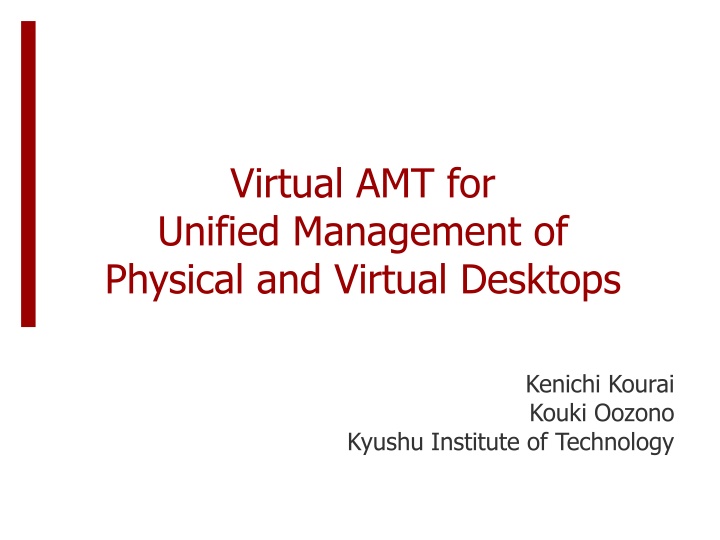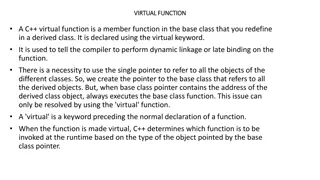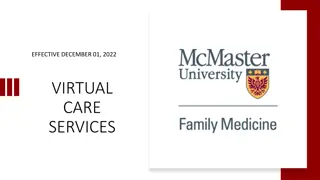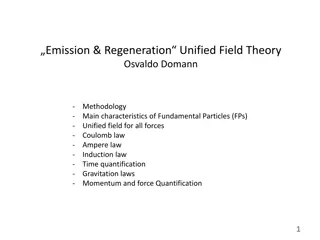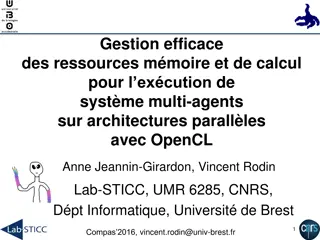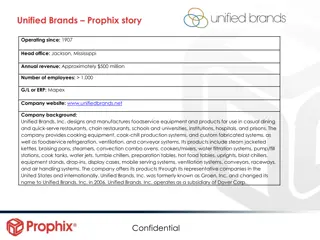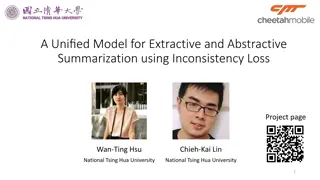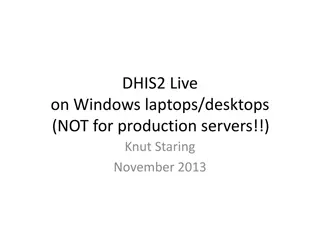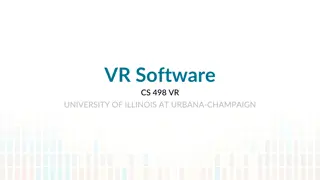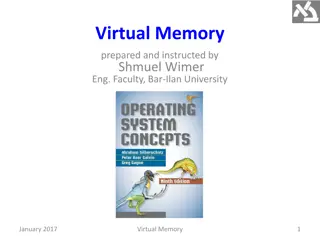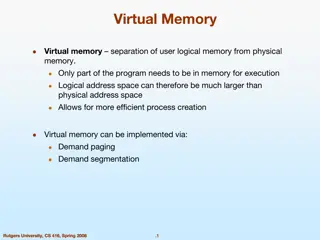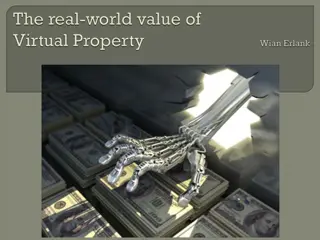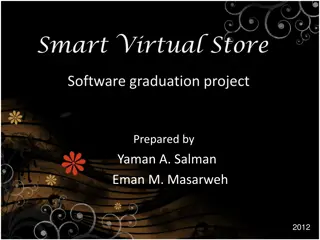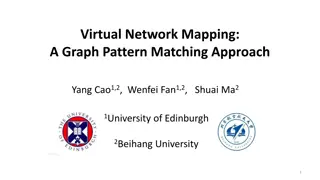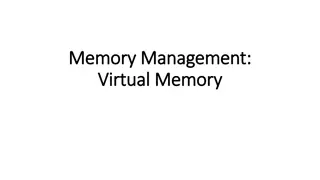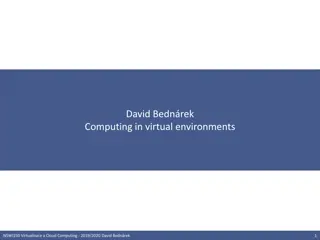Unified Management of Physical and Virtual Desktops
Virtual AMT technology enables unified management of physical and virtual desktops, leveraging Active Management Technology (AMT) for seamless control. Explore how admins can streamline management tasks, consolidate desktops in servers, and enhance remote access capabilities with AMT and virtual AMT.
Download Presentation

Please find below an Image/Link to download the presentation.
The content on the website is provided AS IS for your information and personal use only. It may not be sold, licensed, or shared on other websites without obtaining consent from the author.If you encounter any issues during the download, it is possible that the publisher has removed the file from their server.
You are allowed to download the files provided on this website for personal or commercial use, subject to the condition that they are used lawfully. All files are the property of their respective owners.
The content on the website is provided AS IS for your information and personal use only. It may not be sold, licensed, or shared on other websites without obtaining consent from the author.
E N D
Presentation Transcript
Virtual AMT for Unified Management of Physical and Virtual Desktops Kenichi Kourai Kouki Oozono Kyushu Institute of Technology
Desktop Management The number of desktop PCs becomes enormous Admins manage them remotely Agent software is installed in desktops Agent-based management tools cannot access turned-off desktops Or desktops under system failures or attacks PC PC management tool ... ... agent agent
Intel AMT What is Active Management Technology (AMT)? Embedded processor separated from main CPUs Enable agentless remote management of turned- off desktops Provide hardware information Reboot desktops Provide remote GUI control Restrict network access PC Z z z AMT management tool
Virtual Desktops Run as virtual machines (VMs) in servers Users access them remotely Desktop as a Service (DaaS) Enable consolidating desktops in servers Admins can maintain desktops more easily Software installation/update server virtual desktop keyboard/mouse ... VM VM screen
Physical and Virtual Desktops Two types of desktops are mixed The transition is in progress Difficult to use virtual desktops in laptop PCs Admins have to use two management tools For AMT and for VMs Increase the burden of desktop management virtual desktop ... PC tool tool for PCs ... for VMs AMT ... AMT VM VM
Virtual AMT (vAMT) Enable managing virtual desktops like physical ones Provide the same interfaces as AMT Absorb differences from physical desktops Admins can perform unified management using AMT and vAMT virtual desktop ... PC management tool ... VM VM ... AMT AMT vAMT vAMT server
(v)AMT Interfaces WS-Management Allow remote management with CIM CIM provides a definition of management information SOAP Allow remote management with Web services Deprecated from AMT 6.0 but still used Keyboard/Video/Mouse (KVM) Allow out-of-band remote GUI control with VNC
Monitoring Virtual Desktops vAMT returns hardware information on a VM Obtain information of all elements or a specific element E.g., virtual CPUs, memory, power state vAMT emulates non-existent hardware as necessary E.g., temperature, voltage, manufacturer EnumerateInstances VM vAMT information on CPUs management tool
Controlling Virtual Desktops vAMT changes hardware state of a VM Invoke methods defined in CIM E.g., power on/off, CPU enabling/disabling vAMT ignores requests of state changes to non- existent hardware E.g., fan speed, WiFi state RequestPowerStateChange() reboot vAMT VM Success management tool
Out-of-band Remote Control vAMT provides a VNC server for a VM Obtain the screen of a VM Inject keyboard/mouse inputs to a VM This remote control does not depend on a VM Useful at boot time Available even if network failure occurs inside a VM VNC VNC server VM management tool vAMT
How to Access Turned-off VMs? PCs always exist as concrete hardware AMT can access hardware without regard to its power state E.g., power management, VNC connections VMs are destroyed after power off The virtualized system can manage only running VMs vAMT cannot access turned-off VMs PC VM VM power off power on/off
Accessing Turned-off VMs (1/2) vAMT accesses a turned-off VM through its config file Obtain hardware information written in the config file E.g., virtual CPUs, memory Create a VM from the config file when power on vAMT integrates information from a running VM and a config file seamlessly VM management tool vAMT config file
Accessing Turned-off VMs (2/2) vAMT uses a VNC proxy to access a VM The VNC proxy handles access to a turned-off VM Return a dummy black screen Ignore keyboard/mount inputs It redirects requests to a VNC server for a running VM vAMT switches emulation and redirection automatically VNC proxy VNC server VM management tool vAMT
How to Manage Migrated VMs? A VM can be migrated to another host Attached vAMT is not migrated together Possible approaches Restart vAMT at the destination host Existing network connections to vAMT are tore down vAMT remotely accesses a migrated VM The source host cannot be shut down forever VM vAMT source host destination host
Managing Migrated VMs Run vAMT in another VM and co-migrate vAMT with a target VM Network connections to vAMT are maintained The source host can be shut down D-MORE [Kawahara et al.'14] enables synchronized co- migration of two VMs Solve timing issues vAMT VM source host destination host
System Architecture OpenPegasus CIM Tomcat providers VM libvirtd CIMOM Web services WS-Man server Axis2 QEMU-KVM Apache web server rfbproxy vAMT
CIM Providers CIMPLE generates templates of CIM providers from MOF files The MOF files are provided by Intel Include the definitions of CIM classes We have implemented 39/264 providers CIM providers access a VM using libvirt CIMPLE class CIM_Processor : CIM_LogicalDevice { uint16 CPUStatus; uint32 EnableDevice(boolean Enabled); ... }; CIM Provider implement
Types of CIM Providers Instance provider Manage multiple instances with different properties for a CIM class Association provider Manage the relationship between instances of different CIM classes CIM_Processor provider CIM_Realizes provider CIM_Chip provider instances instances CPU 0 Chip 0 CPU 1 Chip 1
Web Services WSDL2Java generates templates of Web services from WSDL files The WSDL files are also provided by Intel We have implemented 20/522 operations Web services access a VM using libvirt-java They returns responses with complex data structure CbFilterEnumerateResponse PT_STATUS UnsignedInt CircuitBreakerFilterInfoType CircuitBreakerFilterType FilterName_type0 CircuitBreakerFilterDirectionType CircuitBreakerProfileType UnsignedInt CircuitBreakerPacketType CircuitBreakerPacketTypeChoice_type0 CircuitBreakerPacketIPType CircuitBreakerIPPacketType CircuitBreakerIPPacketTypeChoice_type0 CircuitBreakerIPv4Type CircuitBreakerIPv4AddressAndMaskType CircuitBreakerFilterIPAddressDirectionType IPv4AddressStringType IPv4AddressStringType UnsignedByte bool UnsignedInt
Experiments Objectives Confirm that tools for AMT can be used for vAMT Compare the performance of vAMT with that of AMT AMT 7.1.4 Intel Core i7 (3.4 GHz) 2 GB memory Xeon W3550 (3.06 GHz) 6 GB memory AMT 1 vCPU 1 GB memory VM management tool Intel Core i7 (2.93 GHz) 4 GB memory vAMT
Connection: 97 requests of 26 CIM classes and 5 Web services to vAMT
Obtaining the AMT Version WinRM sent a request for one CIM class GetInstance where InstanceID=AMT WinRM vAMT Version=... > winrm g cimv2/CIM_SoftwareIdentity?InstanceID=AMT -r:http://192.168.0.173:16992/wsman CIM_SoftwareIdentity InstanceID = AMT IsEntity = true VersionString = 7.1.4
Performance Results Physical desktop with AMT More than 2 seconds in a turned-off PC AMT was in the sleep mode Virtual desktop with vAMT vAMT was always faster than AMT The host CPU was faster than the AMT chip 2.5 2.1 AMT (power off, 1st) AMT (power off, 2nd) AMT (power on) vAMT 2.0 time (sec) 1.5 1.0 0.4 0.5 0.1 0.06 0.0
Complex Operations AssetDisplay sent multiple requests for each operation CPU information, power off > AssetDisplay -processor -host 192.168.0.173 Device ID: CPU 0 Stepping: 7 Max Clock Speed: 2930 CPUStatus: CPU Enabled Role: Central Family: 198 Upgrade Method: Other Manufacturer: Intel Corp. Version: Intel(R) Core(TM) i7 CPU @ 2.93GH Physical Position: CPU 1
Performance Results Obtaining CPU information AMT was 1.9 times slower than vAMT Due to searching association information Turning the power off vAMT was faster than AMT Performance difference was small 1.5 time (sec) 1.0 AMT vAMT 0.5 0.0 CPU info Power off
Related Work OpenIPMI lanserv simulator [Minyard] Communicate with a virtual IPMI device of QEMU-KVM Used for testing management tools for IPMI CIM extension for virtualization [DMTF'07] Enable managing both physical and virtual desktops Still require differentiating them VMware Horizon View, Microsoft SCCM Support both physical and virtual desktops Provide only agent-based management
Conclusion vAMT for managing virtual desktops Provide the same interfaces as AMT for physical desktops Enable unified desktop management Worked well with existing management tools for AMT Future work Implement all the CIM providers and Web services E.g., packet filtering Implement unsupported interfaces E.g., serial over LAN (SOL)
